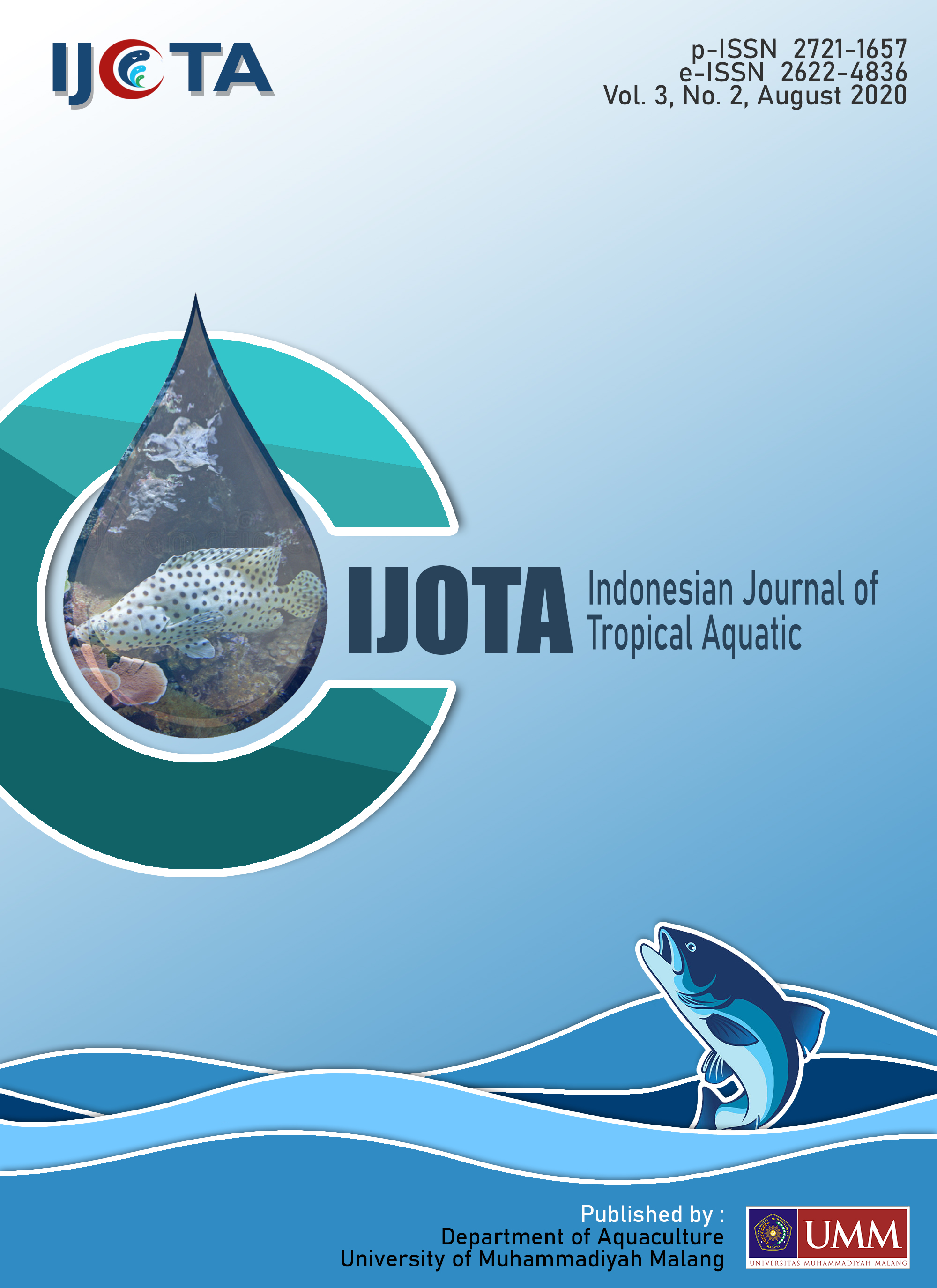Rearing and Spawning Technique of Clown Loach (Chromobotia macracanthus, Bleeker 1852) in Research Institute for Ornamental Fish Culture of Depok, Indonesia
DOI:
https://doi.org/10.22219/ijota.v3i2.13649Keywords:
Botia, Fertility, Hatching rate, OvaprimAbstract
The high demand of botia fish (Chromobotia macracanthus) in the market lead to its sustainability in nature being threatened. The purpose of this technical report is to describe the broodstock and spawning techniques of botia fish carried out at the Research and Cultivation Center for Freshwater Ornamental Fish (BRBIH) Depok, West Java. This activity was carried out from December 2019 to January 2020. This study used two female cows with a spawning ratio of 3 : 1. The average length of the female parent is 9.5 cm with an average weight of 33.5 g, while the length of the male parent is 15.3 cm with an average weight of 56.3 g. Spawning is done artificially using ovaprim. The result of this study was the fecundity value of an average of 8 453 eggs / ind. The average FR was 86.15 %, and the average HR was 78.15 %.
Downloads
References
Ariyanto E, Anwar S, Sofian. 2019. Indeks Prevalensi dan Intensitas Ektoparasit pada Ikan Botia (Chromobotia macracanthus) di Sumatera Selatan. Jurnal Ilmu-ilmu Perikanan dan Budidaya Perairan. 14 (1): 55–62.
Ghofur M, Harianto E. 2018. Inerja Produksi Ikan Botia (Chromobotia macracanthus) Padat Tebar Tinggi dengan Sistem Resirkulasi. Jurnal Akuakultur Sungai dan Danau. 3(1): 18–24.
Ghofur M, Sugihartono M, Aulia HD. 2018. Suhu Optimal untuk Kelangsungan Hidup Pemeliharaan Larva Ikan Botia (Chromobotia macracanthus). Jurnal Akuakultur Sungai dan Danau. 3(2): 50–55.
Kusrini E, Cindelaras S, Prasetio AB. 2015. Pengembangan Budidaya Ikan Hias Koi (Cyprinus carpio) Lokal Di Balai Penelitian dan Pengembangan Budidaya Ikan Hias Depok. Media Akuakultur. 10(2): 71–78.
Liyana SH, Sari LA, Agustono. 2019. Evaluasi Pengaruh Hormon Gonadotropin pada Tingkat Kematangan Gonad Ikan Botia (Chromobotia macracanthus). Jurnal Perikanan Pantura. 2(2): 98–105.
Makmur S. 2006. Fekunditas dan Diameter Telur Ikan Gabus (Channa striata Bloch) di Daerah Banjiran Sungai Musi Sumatera Selatan. Jurnal Perikanan. 8 (2): 254–259.
Putra HFE, Rahardjo SSP, Permana A. 2017. Pemijahan Ikan Hias Botia (Chromobotia macracanthus Bleeker) Secara Buatan dengan Injeksi Hormon HCG (Human Chorionic Gonadotrophin) dan LHRH-a (Luteinizing Hormone Releasing Hormone-Analog). Journal of Aquacultur and Fish Health. 6(3): 101–109.
Salawiyah SRN. 2007. Kebiasaan Makan Ikan Botia (Chromobotia macracanthus) Di Daerah Aliran Sungai Musi, Sumatera Selatan. Skripsi. Respository IPB. 15–16.
Satyani D, Mundriyanto, Subandiyah H, Sudarto F, Taufik, Slembrouck J, Legendre M, Pouyaud L. 2007. Teknologi Pembenihan Ikan Hias Botia (Chromobotia macracanthus Bleeker) Skala Laboratorium. Loka Riset Budidaya Ikan Hias Air Tawar dan Institute de Recherche pour le Development. pp.12.
Setyono B. 2009. Pengaruh Perbedaan Konsentrasi Bahan pada Pengenceran Sperma Ikan ‘’Skim Kuning Telur’’ Terhadap Laju Fertilisasi, Laju Penetasan dan Sintasan Ikan Mas (Cyprinus carpio). GAMMA. 5(1): 6–13.
Sukendi. 1995. Pengaruh Kombinasi Penyuntikan Ovaprim dan Prostaglandin F2α Terhadap Daya Rangsang Ovulasi dan Kualitas Telur Ikan Lele Dumbo (Clarias gariepinus). Program Pascasarjana. Institut Pertanian Bogor. Jawa Barat. pp. 19.
Tang UM, Afandi R. 2001. Biologi Reproduksi Ikan. Pusat Penelitian Kawasasan Pantai dan Perairan. Universitas Riau. Riau. pp. 29.
Tridjoko D, Makatutu, Sugama K. 1996. Pengamatan Pemijahan dan Perkembangan Telur Ikan Kerapu Bebek (Cromileptes altivelis) pada Bak Secara Terkontrol. Jurnal Penelitian Perikanan Indonesia. 2(2): 55–59.
Downloads
Published
How to Cite
Issue
Section
License
Copyright (c) 2020 Mita Winarti

This work is licensed under a Creative Commons Attribution-ShareAlike 4.0 International License.
IJOTA (Indonesian Journal of Tropical Aquatic) allows readers to read, download, copy, distribute, print, search, or link to its articles' full texts and allows readers to use them for any other lawful purpose. The journal allows the author(s) to hold the copyright without restrictions. Finally, the journal allows the author(s) to retain publishing rights without restrictions
- Authors are allowed to archive their submitted article in an open access repository
- Authors are allowed to archive the final published article in an open access repository with an acknowledgment of its initial publication in this journal


